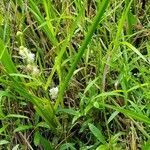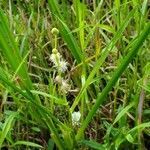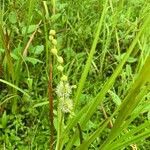Stout, erect, 3–10 dm; lvs to 1 m, 4–12 mm wide, usually thin and flat, occasionally weakly carinate; bracts often dilated at base; infl simple or branched; pistillate heads on the central axis 2–4, on the branches 1–3, all sessile, 2 cm thick when ripe; stipe 2–3 mm; tep two-thirds as long as the fr, dilated at the tip; achene-body fusiform, dull, sordid brown, 3–5 mm, slightly constricted, the beak straight, 1.5–4.5 mm; staminate heads 1–5 on the branches, 3–10 on the main axis. Mud or shallow water of swamps and ponds; Nf. and Que. to Minn., s. to Fla. and La.
The leaves can be erect, floating or under the water. The erect leaves are rigid while the leaves under water are ribbon-like and soft. The leaves under the water can be 3 cm across. The erect leaves are 1.3 cm wide. The flowers are in greenish-white heads.




